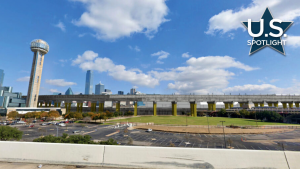According to Ontario’s Minister of Transportation Steven Del Duca, the province is in an era of what he likes to call simultaneous catch up and keep up.
"Catch up of course because of the chronic under investment (in infrastructure)…and keep up because our needs continue to increase as our population, particularly in urban and suburban Ontario, continues to grow rapidly," he explained, adding transit is at the forefront of this. "We know we are well past the point where gridlock is simply an inconvenience."
Del Duca made these comments during the North American Rail P3s portion of the Canadian Council for Public-Private Partnerships (CCPPP) national conference in Toronto.
"Year after year governments at all levels and of every partisan stripe chose to under invest in infrastructure," he said. "Those same governments, for the most part, were unfortunately unable or unwilling to innovate. They surrendered to the belief that this was how it all was being done."
He was quick to point out the current provincial government’s commitment to spend $130 billion on infrastructure over the next 10 years and how its Alternative Financing and Procurement (AFP) model has shown success in the past and will continue to excel in the future.
"We have forged a homegrown track record of success with AFP projects," he stated, adding of the 45 AFP projects that reached substantial completion as of March 31, 2015, 44 were delivered on budget.
"Our government’s commitment to the AFP model will not waver. We still have much more to build."
One of those projects to potentially build is a high-speed rail network that will connect Toronto to Windsor, passing through Kitchener-Waterloo and London. It is currently in the environmental assessment (EA) process, Del Duca added.
Recently, the province appointed a former federal minister of transport, David Collenette as a special advisor on high-speed rail who will look at potential economic development opportunities, work with various public and private stakeholders and provide advice on a preliminary business case and potential financing models.
"One of the things that I know is really important to the premier is that the EA process that we launched last December, would normally take four to six years for MTO (Ministry of Transportation) to complete. She didn’t want, we didn’t want, to be in a world where we finished that work…and then we spend a couple of years beyond that figuring out what a business case would look like, what a financing model might look like," Del Duca added. "She wanted to make sure we could run these processes as concurrently as possible. He (Collenette) will have a number of responsibilities, but one of them is to basically be creative."
But implementing high-speed rail isn’t something that should be taken lightly, as there are many factors to consider, a panel immediately following Del Duca’s address highlighted. The panel "High Speed Rail: Finding Its Place in North America" included moderator Conor Kelly, managing director, Rubicon Infrastructure Advisors; Rob Holden, chairman, High Speed One and former CEO, Crossrail Limited; Sebastien Sherman, senior managing director, Americas, Borealis Infrastructure; Tim Keith, CEO, Texas Central Partners; and Huang Difu, general manager, China Railway International Co.
For Holden, it comes down to figuring out exactly what you want.
"For a country like Canada, which is concentrating on high-speed rail for the first time, I guess I would ask you to ask yourselves some questions to begin with. What do you mean by high-speed rail? It means different things to different people," he explained. "It can mean travelling at 200 kph and high-speed rail can mean travelling at 400 kph, or any speed between those two points."
And the costs between the two can differ significantly.
"The second question is: why do you want high-speed rail? You can have high-speed rail for a number of different reasons," he added. "Within the U.K. I don’t think we could envision a life without High Speed One today. It was a decision to use the railway as a catalyst for regeneration. There’s lots of questions in the planning. Communication is hugely important."
Keith, who’s company is developing a new high-speed passenger rail system in Texas that will connect Dallas/Fort Worth and Houston, said they have faced some challenges with pushing the message out about the project. Unlike other high-speed rail projects, it is backed by private investors, not public funds. Service is expected to begin as early as 2021, a website on the project reads.
"As a private company we’re a taxpayer. We’re infrastructure funding infrastructure," he said, adding the biggest challenge has been introducing the product to the market as in Texas driving is predominant.
Managing policy and working with government are also factors that were carefully considered he said.
"We’re getting rules written around our project," Keith stated. "It’s not easy to create a high-speed rail system today. The time is now in North America."
The time may also be now for Ontario, Del Duca said.
"I think what we’ve signaled with the appointment of Mr. Collenette is that this is real for the premier, it’s real for our government," he added. "We want to get on with this and we want to be as open-minded and as creative as possible to deliver the outcome the people of the province are looking for."



Recent Comments
comments for this post are closed